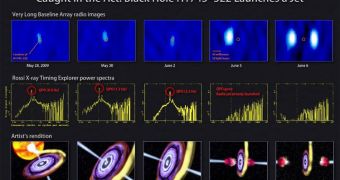A massive outburst caused by a black hole inside our own galaxy was recently reconstructed by experts with an international team. They say that the ultradense object released two massive gas clouds following a cataclysmic event that occurred in the binary system H1743–322.
The NASA HEAO-1 spacecraft was the first to discover this system, back in 1977. Made up of a normal star and a black hole, it is located about 28,000 light-years away, in the direction of the constellation Scorpius.
One of the things that scientists don't know about the system is the mass of the black hole. While they can't be certain of their measurements, investigators believe the object is only of modest size and mass.
In the recent study, the object was surveyed using the US National Science Foundation's (NSF) Very Long Baseline Array (VLBA), which stretches from Hawaii to Puerto Rico and the NASA Rossi X-ray Timing Explorer (RXTE) satellite, which was retired from active service on January 5.
Archival telescope data reveal that an interesting transition occurred in this binary system in early June 2009. The event repeats itself periodically, but usually at lower intensity, and occurs when some of the matter falling into the black hole's accretion disk is redirected outwards.
Usually, this is done via an increase in radiation emissions. Every so often, the event is more violent, and manifests itself through the black hole hurling massive blobs of gas in space. For the 2009 event, the blobs were traveling at relativistic speeds, of nearly 25 percent the speed of light.
Subsequent studies of the outburst revealed that it originated just outside the black hole's event horizon, which is the theoretical limit of how close an object can get to such a structure before reaching the point of no escape.
“Like a referee at a sports game, we essentially rewound the footage on the bullets' progress, pinpointing when they were launched,” University of Alberta astronomer Gregory Sivakoff explains.
“With the unique capabilities of RXTE and the VLBA, we can associate their ejection with changes that likely signaled the start of the process,” adds the expert. He presented the findings on January 10, at the annual meeting of the American Astronomical Society (AAS2012), in Austin, Texas.
University of Durham astrophysicist Chris Done, who was not a part of the research team himself, believes that this work could be used to provide a deeper understanding of the conditions that need to come to pass inside a black hole, in order for it to produce such a gas jet.

 14 DAY TRIAL //
14 DAY TRIAL //